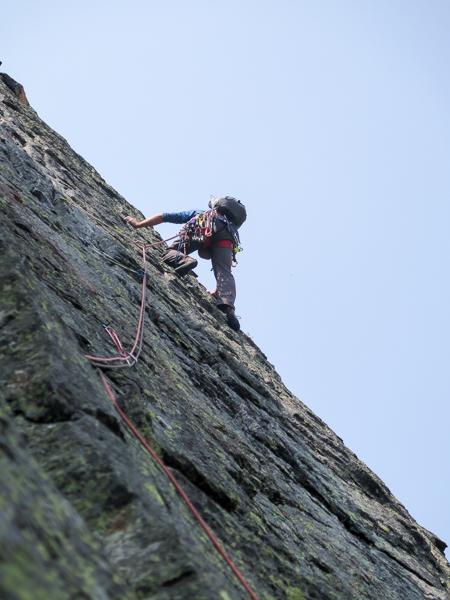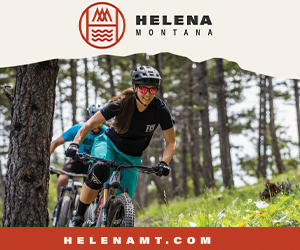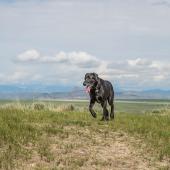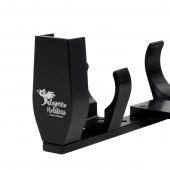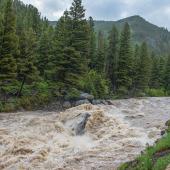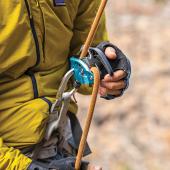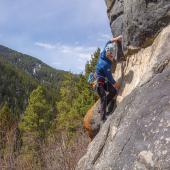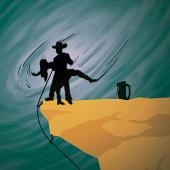One Misstep
Ted Border and I had been friends for 35 years and climbing partners for 28. Together we’d summited more than 50 mountains around southwest Montana. In all those years, mishaps had been utterly nonexistent.
Until today.
From our vantage point at lunch, we could see the terrain on the east side of the ridge leading to Mt. McKnight, and we found it to be quite a bit steeper than anticipated. The entire slope was a series of 80-degree rock ledges covered with grass and a few trees. The face resembled a huge staircase with each "step" averaging 20 feet in height. The ledges appeared to be level and fairly wide, and most importantly, they led to where we wanted to go.
The going at first was fairly straightforward; however, after a few hundred feet of horizontal scrambling, the ledges became narrower and more slanted. Eventually Ted and I came to a point where the ledge gradually became smaller and after several feet vanished into the side of the mountain. We decided to work our way down the face to look for another horizontal path. It didn't take Ted long to discover a route down with suitable hand and foot holds for us to use. We quickly descended the 15 feet to the next ledge.
We realized that to continue across the face we would need to negotiate a five-foot gap in our new ledge. Ted made the leap across the chasm with his usual ease. When I came to the same gap, however, I hesitated, because one misstep would be the beginning of a long fall down nature's staircase. With arms and legs shaking with fear and fatigue, I finally drummed up the courage to fall the few feet that seemed like 20 onto the next ledge. I landed slightly off balance, but Ted, of course, was there to steady me.
After giving me a few seconds to gather myself, Ted turned south and began walking across our new ledge. As he moved along the rock, he came to a spot where the ledge narrowed to a grassy strip about a yard long and four inches wide. He probably could have stepped over the strip, but instead, he stepped in the middle of it without realizing that the grass was wet with run-off from the ridgeline above. Ted's hiking boot slipped immediately out from underneath him, and he began to slide on his stomach down the rock face with startling speed.
His first reaction was to dig his toes and fingers into the rock, grass, and dirt that he was sliding on. When that didn't work, he quickly turned himself around into a sitting position and attempted to grind the heels of his boots into the ground, hoping a foothold would arrest his slide. At this point, however, his momentum was too great. When Ted's heels did finally catch, they acted like a fulcrum point and sent him flying headfirst over a 15-foot ledge that was just the beginning of a horrific fall. The only thing I could think to do was yell probably one of the most unintelligent things that I've ever said in my life: "Hang on, Ted! Hang on!"
Ted was now cartwheeling down the mountain, going over ledge after ledge. He never said a word during the entire fall, but I will never forget the grunting sound he made every time he hit the ground. Finally, Ted landed on a ledge that was wide enough to give him a chance to slow his momentum. His body rotated another half-turn, and he fell another six feet onto a tree-covered ledge. The trees were enough to finally kill his momentum.
The entire fall probably lasted five seconds, but it felt like an eternity. Ted had fallen approximately 200 feet over eight or nine ledges. The largest one was around 30 feet high. The ledge he stopped on was only four feet wide. If he had rolled off that one, he would have fallen another 200 feet onto some jagged rocks at the top of a large snowfield that eventually flattened out onto a bench as wide as a city street.
In obvious panic, I had started down the slope while Ted was still falling. As I got closer, I could hear Teddy groaning loudly. He was on his back and his face was covered in blood. "Mikey, I'm so sorry," he said over and over again. I assured him that there was no need to apologize.
Ted's backpack was still strapped to his back. I helped him slip it off to get to the first-aid kits. The plastic container that housed his first aid supplies had exploded into a hundred pieces.
"How far did I fall?" Ted asked as I stood over him checking his upper body for internal injuries.
"About 150 to 200 feet," I replied.
"How far did I fall?" he asked again only 30 seconds later. I knew then that the condition of his bloody head was as bad as it looked.
I continued checking Ted's entire body for injuries. His stomach, chest, and back areas looked okay except for some scrapes and bruises. Both of his legs were in good shape even though he complained of heel pain. His back hurt too, and no matter what position we put him in, nothing seemed to relieve the discomfort. His arms took the biggest hit. Ted's right elbow looked like raw hamburger. He had four or five deep cuts that were filled with dirt and bleeding heavily, but nothing appeared to be broken. As I ran my hand up his left arm, I felt the bone of his lower arm pushing up the skin of his triceps muscle.
Sweat was pouring off my face, and my hands were shaking. My first job was to get the bleeding from his head under control, so I grabbed gauze from one of our first-aid kits and began dabbing at his two-inch head gash. The bleeding had already slowed somewhat; it didn't take long to stop the flow. I used Ted's rain pants as a makeshift sling to keep his dislocated left elbow immobilized.
Once Teddy was bandaged up, we tried to put him in a comfortable position on the narrow ledge. It didn't seem to matter how we positioned him; the pain wasn't going away. The heat of the sun was blazing down on us with 9,000-foot intensity, causing even greater discomfort. I finally said to him, "Teddy, I'm going for help."
"You can get me down," he replied.
I glared at my friend in stunned disbelief. There was no possible way for me to transport Ted down the mountain without causing him further harm. "No, Ted," I said sternly, "I'm going to get help!"
"You can get me down," he repeated.
"Teddy, we can either do this right, or we can screw it up. Now what would you rather have me do? Get you killed or get you help?" As long as Ted and I have been friends, it's probably the only time that I've yelled at him.
The decision was made.
I made sure that Ted had all the items he would need before I left: two water bottles, both of our raincoats, a watch, a stocking cap, and other warm items of clothing. The sun would soon be slipping behind the ridge, so I wanted to make sure he would be as comfortable as possible. I brought nothing with me, because I’d be running and didn't want to be weighted down.
The first problem I had was finding a route down from the ledge that we were stuck on. I was obviously spooked after witnessing Ted's fall, so the ten-foot drop to the three-foot wide ledge below us seemed like a drop off of the Sears Tower. Once again, my legs and arms shook as I lowered myself as far as I could before finally letting go.
The new ledge led north in an arc to another section of the snowfield. I ran hard when I got close to the snowfield, hoping to gain as much momentum as I could. Snow exploded off the surface as I began a 200-foot ride on my rear that would lead me to the meadow on the east side of the Davis Creek Divide. Once I reached the meadow, I ran back up to the divide to begin the six-mile trip back to the car.
I had been a runner all of my life, so I didn’t worry about running until I found someone to help us. The time was now slightly past 1 pm, and the heat of the day was kicking into full throttle.
After covering six miles in an hour, I ran into a couple about a mile from the trailhead. Barth and Kathy Schretenhaler looked startled as I came around a corner at full speed and headed right for them. I told them what had happened and Barth immediately took off down the trail to call the Park County Search and Rescue.
I turned around and headed back up toward Ted.
I began to struggle about two miles back up the trail. The temperature had risen considerably, and the flies were swarming. I drank from every stream I came to. I began to sit down on the trail for short periods, not wanting to move but knowing that I had to if I was ever going to get back to Ted.
I had a bad feeling that Ted was already dead on the tiny ledge. My exhausted, irrational mind began to wander, wondering what words I would use to tell Ted's family about how he died. I knew people were going to ask me why we were in such a difficult spot without the proper equipment. I started to think about the hundreds of sad people who would be at the funeral partially because of me. And then I heard it: the little voice in the back of my head. "You aren't going to quit are you? You told Ted you would come back, so you better not let him down."
I decided I was going to battle, to get up and make the push back to Ted. At least I could live with myself knowing I had done my best for my friend.
Just before reaching the switchbacks, I ran into some people we had seen earlier that day. Roger Boyd and Sabine Klahr immediately turned around and headed back up the trail once I explained Teddy's situation. Two minutes after meeting up with Roger and Sabine, a father and son we passed that morning came down the trail. Rick Maroney and his ten-year-old boy Owen agreed to join us on the trip back up the switchbacks.
Our little party didn't last long, however, because I just couldn't keep up. I felt like my cement legs were not going to go any further when I heard what seemed like music: a helicopter. I couldn't see it, but I could definitely hear it. It was coming from the south, heading directly for Ted's location. Barth's directions must have been precise.
While I stood on the divide, the helicopter hovered directly in front of me. I assumed the crew was trying to determine if I was Ted's companion. The pilot, Curt Wainwright of the Yellowstone Park Search and Rescue, decided to ask for some direction, so he began the difficult process of trying to land a helicopter on a mountain pass in 40-mile-per-hour wind. One of his partners, Andy Mitchell, jumped out the door and ran toward me.
"Are you the partner?" he yelled.
"Yes!" I replied, trying my best to be heard over the roar of the wind.
"We can't locate him! We've dropped a man in the general location, but we still can't find him," Mitchell said.
"I'll go and point him out to you."
Mitchell sprinted back to the helicopter while I hurried down the east side of the divide to the meadow and back up to the bench just below Ted's location. As I got closer to the ledge, I started to panic because I couldn't see him anywhere.
Was he passed out on the ledge? Was he asleep? Or was he dead?
I finally spotted him sitting about 15 yards south of his original position with his legs dangling off the ledge. He was wearing a stocking cap and all of the other warm gear. In the fading light, the jagged east wall looked ominous, almost prison-like. Hoping to be relieved of his five-hour incarceration, Ted silently stared down at us.
We were pointing out Ted's position when we spotted the man that Mitchell and Wainwright had dropped off on the face. Sean Graf was 50 yards north of Ted on one of the ledges. The three of us started once again to climb up to Ted's ledge, but Graf finally made it to Ted and told us to go back down; he didn't want anyone else taking a fall.
The helicopter hovered in for a better look at Ted as Graf yelled, "Ted, can you tell me about your injuries?"
No answer.
Graf yelled again, "Ted, can you tell me about your injuries?"
Ted again didn't say anything, but this time he shook his head from side to side, indicating to Sean that he wasn't very coherent. Graf pulled out his walkie talkie and began planning the helicopter crew's next move.
After ten minutes of preparation, the chopper maneuvered back up to the ledge with Andy Mitchell riding a basket that was attached to the static line. The wind had not let up, affecting Wainwright's ability to hold the helicopter steady as he glided Mitchell to the ledge next to Ted. Wainwright tipped the chopper nearly 20 degrees into the wind to keep the helicopter steady. It was obvious to all of us that Wainwright was an extremely skilled pilot. Within a few minutes, the chopper gently pulled away from the mountain face with Mitchell and Ted suspended below.
Back at the meadow, the chopper crew switched Ted from the basket into the fuselage and gathered equipment for the ride to the trailhead. I told Ted I would see him at the hospital, and with that the helicopter lifted off, turned west, and thundered over the Davis Creek Divide one last time. I have never experienced such a sense of relief in my entire life.
The staff at the Livingston Memorial Hospital took excellent care of Ted. During his overnight stay he received blood, had his dislocated elbow put back into place, and his many cuts and bruises treated. In the weeks that followed, his entire lower body turned black from the punishment he took from the fall. He has never regained the full range of motion in his left elbow. Ted's back has also bothered him persistently since the fall, but considering the beating he took, we feel fortunate that he is in as good as shape as he is.
Ted and I have continued to climb in southwest Montana, enjoying it with an even greater appreciation than we did in the past. Our level of caution, obviously, has increased greatly, knowing first hand that disaster is only one misstep away.


